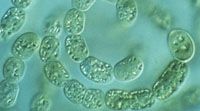Extreme survival of cyanobacteria
Watch this video to find out how the study of cyanobacteria in Antarctica can reveal how life is able to survive in the most extreme conditions on our planet.
Natural History Museum botanist Anne Jungblut talks about her recent trip to Antarctica to study cyanobacterial diversity, and tells us more about these important organisms, which might have dominated early Earth.
Cyanobacteria, the architects of Earth’s atmosphere

An enlarged image of cyanobacteria, an extremely successful group of microorganisms.
Cyanobacteria were some of the first forms of life on Earth, evolving over 2.5 billion years ago. And they have a lot to answer for.
Cyanobacteria were the first photosynthetic organisms to evolve. Before these oxygen-producing bacteria existed the atmosphere on our planet had a very different chemistry, not suitable for most life as we know it today. Oxygen in the atmosphere dramatically changed the composition of life forms on Earth and stimulated biodiversity.
Extreme survival

Large cyanobacterial mat accumulations (red areas) in an Antarctic lake. © Anne Jungblut
Cyanobacteria are able to survive in almost any environment, no matter how extreme. From hot springs to Antarctic lakes, cyanobacteria can be found in almost every terrestrial and aquatic habitat on Earth.
Museum scientist Anne Jungblut is studying cyanobacteria in Antarctic lakes to try and understand how these organisms are able survive where no other life can.
It appears part of the answer lies with their ability to form large communities called microbial mats. Containing lots of different species, these communities appear to be able to overcome nutrient-deficient conditions by recycling nutrients. And many Antarctic cyanobacteria produce antifreeze compounds and UV screens, which help them cope with the low temperatures and high ultraviolet radiation during the summer.
Even NASA has shown an interest in these organisms. Cyanobacteria have been taken into space to see if they survive. They can!